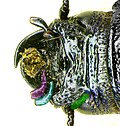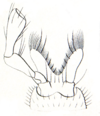Temnochila caerulea
| Temnochila caerulea | ||||||||||||
|---|---|---|---|---|---|---|---|---|---|---|---|---|

Temnochila caerulea |
||||||||||||
| Systematics | ||||||||||||
|
||||||||||||
| Scientific name | ||||||||||||
| Temnochila caerulea | ||||||||||||
| ( Olivier , 1790) |
Temnochila caerulea is a beetle from the family of the hunting beetle , which belongs to the superfamily of the spotted beetles. The genus Temnochila is represented in Europe with only two kinds , in Central and South America against it with about one hundred kinds.
The generic name Temnochila is derived from the ancient Greek τέμνω, témno , 'I cut' and χεῖλος , chēīlos , 'lip' and refers to the longitudinal furrow from the forehead to the upper lip, the species name caerulea from the Latin caeruleus , 'blue' denotes the body color.
Characteristics of the beetle
The flat beetle (Fig. 1, middle) is about three and a half times as long as it is wide and reaches a length of eleven to eighteen millimeters. The whole body, including the legs and antennae, shines metallic blue, rarely green.
The head (Fig. 5) is almost as wide as the pronotum. It is roughly square and evenly rounded on the sides. The mouthparts point forward. The upper lip is cut straight in front, but appears indented due to the longitudinal impression. The upper jaw has two pointed ends. They have a blunt tooth on the inside (Fig. 5). The grinding surface at the base of the upper jaw is missing. The jaw and lip buttons widen towards the tip (Fig. 3, pink and blue). The forehead is furrowed forward to the upper lip. The eleven-part feelers are pivoted to the side behind the base of the upper jaw. They thicken outwards, the last three links form a loosely separated, loose club. The antennae are bulky, the antennae do not reach the middle of the pronotum. Some of them can be placed in a clearly formed feeler groove that runs below the eyes to the underside of the head (green in Fig. 3 and Fig. 4). The round eyes are strikingly flat (Fig. 5).
The neck shield is strong as head punctured , along the center coarse on the side finer. Its front edge is curved slightly inwards on both sides of the middle and the front corners are only slightly drawn out. It is about the same length as it is wide. The lateral edge is angularly bent behind the middle (Fig. 4, arrowhead), behind it the pronotum narrows to the obtuse-angled rear corners.
The elytra are about as wide as the head and pronotum and narrow a little towards the back. In the end, they are rounded together. They are streaked by rows of narrow elongated dots (Fig. 7, the two lowest rows are green). The spaces in between are furrowed across and have a longitudinal row of rough dots (Fig. 7, yellow in the lowest interval). The sides have narrow margins (Fig. 1, middle). The label is very small.
The rear hips are almost touching, the front and middle hips, on the other hand, are far apart (Fig. 1, bottom). The tarsi are five-limbed with a small first limb and a long claw limb (Fig. 2). The claw link has a membranous appendage between the claws (onychium, Fig. 6).
larva
The larva (Fig. 8) is elongated, only the head and the back plate of the front breast are more heavily sclerotized .
biology
The occurrence of the species is limited to primeval forests (primeval forest relict). The species lives predatory in and under the bark of coniferous wood and was mainly found on freshly felled pines and spruces . The source of food are the larvae of jewel beetles , longhorn beetles and bark beetles .
In various studies in Spain , Temnochila caerulea proved to be the main natural enemy of the twelve-toothed pine bark beetle ( Ips sexdentata ), which is classified as the most harmful bark beetle on coniferous wood on the Iberian Peninsula . The larvae of Temnochila caerulea eat bark beetle larvae , the adults eat adults of the bark beetle. With traditional forest use (removal of dry wood for firewood, debarking of felled trunks) Temnochila caerulea prevents the mass occurrence of the bark beetle.
Temnochila caerulea is not only attracted to the natural pheromones of the bark beetle, but also reacts to the synthetic pheromones that are produced for the beetle traps. The catches in the traps show a coupling of the flight times of the two beetle species. The bark beetle shows three flight maxima per year, corresponding to the three generations. The flight time of Temnochila caerulea begins at the beginning of May at the same time as the first mass appearance of the bark beetle at a temperature of over 16 ° C and ends after its third maximum. At temperatures below 16 ° C during the summer, both types interrupt flight activity. Maxima of the catches of the bark beetle correspond to maxima of the catches of Temnochila caerulea . They were in mid-May, late June and late July.
The hormone traps for the bark beetle also deprive nature of its natural enemy Temnochila caerulea to a considerable extent . A time limit for the use of the traps is ruled out, since the maximum catches for bark beetles and Temnochila caerulea coincide. Even short time intervals between the controls of the traps do not prevent the animals from mutilating in the meantime. The search for a more specific attractant that attracts bark beetles but not Temnochila caerulea is encouraged, but it will not be easy to find. Experiments with a funnel system in connection with a net with a mesh size of 6 millimeters as a trap were successful.
distribution
The species is distributed incoherently in Europe ( Spain , Canary Islands , Italy , France , Germany , Austria , Croatia , Bosnia and Herzegovina , Slovakia , Greece , Bulgaria , Cyprus , central Russia ). It is absent in Northern Europe. To the east, the distribution area extends to Asia.
literature
- Heinz joy, Karl Wilhelm Harde, Gustav Adolf Lohse (ed.): The beetles of Central Europe . tape 7 . Clavicornia. Spektrum Akademischer Verlag, Munich 1967, ISBN 3-8274-0681-1 .
- Gustav Jäger (Ed.): CG Calwer’s Käferbuch . K. Thienemanns, Stuttgart 1876, 3rd edition
- Edmund Reitter : Fauna Germanica, the beetles of the German Empire III. Volume, KGLutz 'publishing house, Stuttgart 1911
Individual evidence
- ↑ a b Temnochila caerulea at Fauna Europaea. Retrieved February 11, 2012
- ↑ Temnochila at Fauna Europaea. Retrieved February 11, 2012
- ↑ Heinz Freude, Karl Wilhelm Harde, Gustav Adolf Lohse (ed.): Die Käfer Mitteleuropas . tape 7 . Clavicornia. Spektrum Akademischer Verlag, Munich 1967, ISBN 3-8274-0681-1 .
- ↑ Sigmund Schenkling: Explanation of the scientific beetle names.
- ↑ Klaus Koch : Die Käfer Mitteleuropas Ökologie . 1st edition. tape 2 . Goecke & Evers, Krefeld 1989, ISBN 3-87263-040-7 .
- ↑ RM Rando: "Estudio de las curvas de vuelo de Ips sexdentatus y de sus principales predatores en diversos montes de la provincia de Teruel en 2008 y 2009" Universidad Politecnica de Valencia, ITForestal ACTA DE CALIFICACIÓN DEL TRABAJO FINAL DE CARRERA as PDF
- ^ A. Belén, M. Hernández, I. Etxebeste, G. Pérez, G. Álvarez, J. Parajes: "Resumen de las modificaciones de trampas de captura masiva para la exclusión física de enemigos naturales de Ips sexdentatus " Instituto Universitario de Investigation , Gestión Forestal sostenible, Universidad de Valladolid as PDF ( page no longer available , search in web archives ) Info: The link was automatically marked as defective. Please check the link according to the instructions and then remove this notice.









